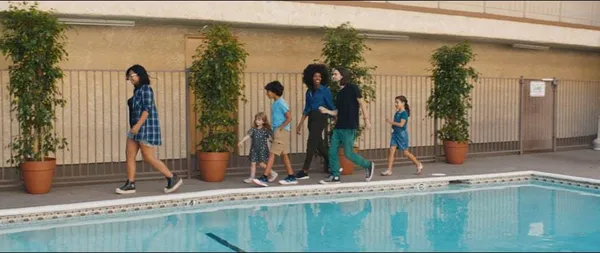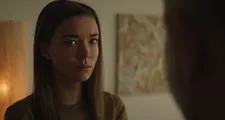 |
| A dream apartment complex? |
In part one of my interview with David Marmor about Apartment 1BR, we discussed the various disasters that beset the production along the way, the fortuitous casting of Nicole Brydon Bloom, and the importance of creating a setting that would leave no room for simple physical solutions, so that viewers would fully appreciate the need for the film’s heroine to escape her situation psychologically. In part two, I began by asking David how he found the location where the film is set, which contributes a huge amount to its character.
 |
| Moving in |
“We had so little money that it was really a case of going out to every apartment complex we could find that was willing to talk to us for the amount of money that we had,” he says. “Eventually there were only two that were even viable, that said (a) the amount of money you’re offering is okay, and (b) would just work physically for the story. When I saw this place it just struck me as perfect. For one thing, it physically resembled the place that I was living in when I wrote the script, so I kind of knew it would work for the story that had been in my head. Also, it had this great quality which is that it’s very sunny, there’s a pool, there’s trellises and trees and if you turn the camera the right way it looks very beautiful and welcoming, but if you turn the camera the other way then it’s three storeys of these square beige breezeways and it looks very much like a prison. It’s this prison that doesn’t quite present as a prison initially. So that was perfect – but it was just lucky that we were able to find any option that would work.”
One of the first things that goes wrong for Sarah (Bloom) after she moves in is that she discovers the pipes behind her bedroom wall make a really loud noise all night, dramatically interfering with hr sleep. Many viewers will wonder how she can stand to live in a place like that. Is it simply an indication of how much pressure people are under when seeking accommodation in Los Angles?
“Yeah, absolutely,” he says. “That came straight out of my experience. I remember when I first moved into this apartment I was so excited about it. It was this beautiful courtyard and I had my own bedroom and everything, and then I went to bed that first night, and it wasn’t pipes – well, there were pipe sounds too – but the thing that really made me think ‘Oh my God, I’m not going to be able to live here!’ was, I was on the second floor and whoever was on the third floor would just walk back and forth across the ceiling, like, for hours, right above my head, and this ‘clonk, clonk, creak, creak,’ and that drove me crazy. I thought ‘Am I never going to sleep?’
 |
| Talking to a friend |
“The thing that happens though – and I guess this is thematically relevant to the script – is that I just eventually got used to it, and then I would sleep right through it. We’re capable of adapting to a lot of things that we don’t necessarily think we can adapt to.”
When we reach the stage of the film where Sarah experiences actual violence, it’s really quite downplayed compared to other films – shocking but simple, using what look like adapted police techniques. Was that a deliberate decision so that he could keep the focus on the psychological?
“There was much more physical torture in the early draft of the script. it was something I never felt great about, especially when I came back to the script as a more experienced writer and I was able to look at it more objectively with the passage of time, and I realised: the thing I’m interested in here is the psychological aspect of this. I felt like the needed to be a scene or a sequence of the physical torture because that was the lynchpin of everything. There’s almost no violence for most of the movie after that but the threat if it is always there because that scene is so horrifying.
“I needed that one scene but I hate the term ‘torture porn’ and I didn’t want it to ever be associated with this movie. That’s not what it was about. So yeah, it was very important to me to do that scene as straightforwardly as possible. It also“ – he hesitates – “it’s scarier to me if it’s done without any sadism or aggression. This is just the technique they do, they’ve all been taught t, they’ve learned how to do it correctly, and it’s just a thing that they do. the direction I always gave to everybody in the community was ‘You are the god guys. What you are doing is for Sarah’s good, you really believe that she’s going to become one of you and you guys are all very happy.’ It was really important to me to feel that there was no malice, there was no creepiness to that aspect of it.
 |
| Who can be trusted? |
“The specific techniques, a lot of them are adapted straight from US government interrogation techniques hat have been developed since the Iraq War, sadly.”
Part of what makes the film effective is that none of the conventional clues help us when it comes to figuring out who Sarah might be able to trust and who she can’t.
“I have a writer friend who told me ‘Always look for ways to trick expectancy.’ You can do that in big ways or in little ways but I’m always looking for things – even in a basic scene, like a character scene, I look for little ways that it kind of goes not the way you would expect it to go... With Lester, when I set him up, he seemed like an important character so you can see the cost of what living here can do to a person, but it wasn’t until a few drafts in that I had the idea that he would become what he did.”
Part of what made all this work for me was that it’s not just a case of people trying to seem nice – some of the characters really are lovely people all the way through, within their limitations.
“The idea for me was that they all do genuinely care about each other,” he says. “I most of their ay to day life it is that genuine. It is real love between them and they are looking out for each other. They’re not monsters. They’ve just all found ways to accommodate and live with the situation that they’re in.”
Toshi the cat, who was a keen participant in the earlier part of our interview, reappears at this point and tries to climb onto David’s elbow. David tries to fend him off, apologising for looking unprofessional, as I ask where his career seems to be taking him now.
“I’m working on my next movie,” he says, recovering, “which I’m going to be doing with the same producers, Alok Mishra, Shane Vorster and Sam Sandweiss. It’s quite different. It’s a science fiction thriller on quite a bit bigger scale than 1BR. I’m really excited about it – it’s been kind of a dream project for me for several years now. We’ve had other directors attached to it. It was never something that I thought I would get to do because I had no résumé as a director, but 1BR has done better than I think any of us expected. The producers are out getting the money right now and while the world is on pause I’m planning to do one more pass on the script, and then hopefully there will still be movies next year.”





















